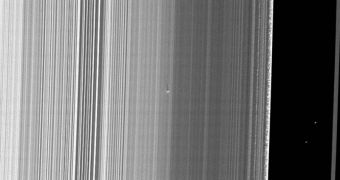According to mission controllers for the Cassini spacecraft, a new object has been found lurking in one of Saturn's rings. The elusive body has thus far not been discovered because of the angles at which the probe moved around the planet, and also because the conditions were right for these types of observations. The find was made possible by the fact that Saturn was at its equinox, which occurs twice a year, or once in every 15 Earth years. The moonlet is about 1,300 feet in diameter, preliminary investigations have revealed.
The equinox will actually take place tomorrow, August 11, but the angle of the sunlight falling on the rings became appropriate for peering inside them a few days earlier. While looking at the planet's B ring, Cassini's cameras picked up a shadow about 25 miles long, which was generated by the tiny celestial body. According to mission controllers, the entire mission was planned so that it captures this time period, in which the light of the Sun falls directly on top of the planet's equator, at noon. This configuration will last for about 27 months.
During this time, any and all celestial bodies that exist in Saturn's rings, and have thus far not been observed directly by Cassini, will generate long shadows, which will be undoubtedly captured by the probe's sensitive cameras. The length of the shadows will allow researchers to estimate the moonlets' size and orbit, which would lead to a better understanding of the workings around the gas giant. According to the most recent data, about 61 moons orbit the planet, along with hundreds of smaller bodies, hidden in the thin rings.
The equinox is also the only time that Cassini will be able to see objects hidden within the rings. If the probe points its cameras at the 30-foot-thick rings on an average day, it cannot even see them, as they are too thin for its cameras to detect. This applies for all the main rings, A, B, C, and D, which experts believe to be holding a large numbers of tiny moonlets. The next couple of years will be used to find and catalog as many of them as possible, Cassini controllers say, Wired informs.

 14 DAY TRIAL //
14 DAY TRIAL //